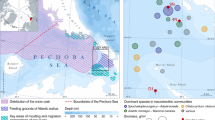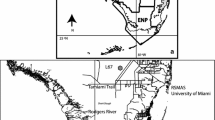Abstract
The proximate and elemental chemical compositions of 25 species of pelagic decapod and mysid crustaceans collected from the eastern Gulf of Mexico (∼27°N; 86°W, 1984 to 1989) was examined. Water level ranged from 63 to 95% and increased slightly with species' increased depth of occurrence. Protein levels were generally high (1.5 to 18.3% wet wt, WW; 27.6 to 62.4% ash-free dry wt, AFDW) and comprised the primary organic component in the majority of species. Protein, both as % WW and % AFDW, decreased with increased depth of occurrence. In contrast to protein, lipid levels were low (0.5 to 8.9% WW; 5.7 to 60.9% AFDW), and increased with increased depth of occurrence. Carbon and nitrogen best mirrored measured lipid and protein levels when considered as non-protein carbon and non-chitin nitrogen, respectively. C:N ratios increased with increased depth, consistent with changes in protein and lipid with depth. Because of their compositional attributes, resident Gulf of Mexico species have a low total wet weight energy content relative to species from more productive regions. Energy content showed no significant trend with depth. Vertical migration patterns were distinctly different between shallow-and deep-living gulf species and these differences were largely responsible for the relationships observed between composition and depth. In migrating species, the protein and nitrogen content were higher, the lipid and carbon contents and C:N ratio lower, than in non-migrating species. Three deep-living species of the genus Acanthephyra were found to be compositionally atypical, resembling shallow, migrating types rather than other deep-living, non-migratory species.
Similar content being viewed by others
Literature cited
Bailey, T. G., Robinson, B. H. (1986). Food availability as a selective factor on the chemical compositions of midwater fishes in the eastern North Pacific. Mar. Biol. 91: 131–141
Chace, F. A. (1940). The bathypelagic Caridean Crustacea. Plankton of the Bermuda Oceanographic Expeditions. IX. Zoologica, N. Y. 25: 117–209
Childress, J. J., Nygaard, M. H. (1973). The chemical composition of midwater fishes as a function of depth of occurrence off southern California. Deep-Sea Res. 20: 1093–1109
Childress, J. J., Nygaard, M. (1974). Chemical composition and buoyancy of midwater crustaceans as function of depth of occurrence off southern California. Mar. Biol. 27: 225–238
Childress, J. J., Price, M. H., Favuzzi, J., Cowles, D. (1990). Chemical composition of midwater fishes as a function of depth of occurrence off the Hawaiian Islands: food availability as a selective factor. Mar. Biol. 105: 235–246
Cowles, D. L., Childress, J. J., Wells, M. E. (1991). Metabolic rates of midwater crustaceans as a function of depth of occurrence off the Hawaiian Islands: food availability as a selective factor? Mar. Biol. 110: 75–83
Culkin, F., Morris, R. J. (1969). The fatty acids of some marine crustaceans. Deep-Sea Res. 16: 109–116
Donaldson, H. A. (1976). Chemical composition of sergestid shrimps (Decapoda: Natantia) collected near Bermuda. Mar. Biol. 38: 51–58
Fisher, L. R. (1962). The total lipid material in some species of marine zooplankton. Rapp. P.-v. Réun. Cons. perm. int. Explor. Mer 153: 129–136
Flock, M. E., Hopkins, T. L. (1992). Species composition, vertical distribution, and food habits of the sergestid shrimp assemblage in the eastern Gulf of Mexico. J. Crustacean Biol. 12: 210–223
Foxton, P. (1970). The vertical distribution of pelagic Decapods (Crustacea: Natantia) collected on the SOND cruise 1965. I. The Caridea. J. mar. Biol. Ass. U. K. 50: 939–960
Foxton, P. (1972). Observation on the vertical distribution of the genus Acanthephyra (Crustacea: Decapoda) in the eastern North Atlantic, with particular reference to the species of the “purpurea” group. Proc. R. Soc. Edinb. (Sect. B) 73: 301–313
Gnaiger, E., Bitterlich, G., (1984). Proximate biochemical composition and caloric content calculated from elemental CHN analysis; a stoichiometric concept. Oecologia 62: 289–298
Goswami, S. C., Rao, T. S. S., Matondkar, S. G. P. (1981). Biochemical composition of zooplankton from the Andaman Sea. Indian J mar. Sci. 10: 296–300
Heffernan, J. J., Hopkins, T. L. (1981). Vertical distribution and feeding of the shrimp genera Gennadas and Bentheogennema (Decapoda: Penaeidea) in the eastern Gulf of Mexico. J. Crustacean Biol. 1: 461–473
Herring, P. J. (1973). Depth distribution of the carotenoid pigments and lipids of some oceanic animals. 2. Decapod crustaceans. J. mar. biol. Ass. U.K. 53: 539–562
Hopkins, T. L., Gartner, J. V., Flock, M. E. (1989). The caridean shrimp (Decapoda: Natantia) assemblage in the mesopelagic zone of the eastern Gulf of Mexico. Bull. mar. Sci. 45: 1–14
Hopkins, T. L., Lancraft, T. M. (1984). The composition and standing stock of mesopelagic micronekton at 27°N 86°W in the eastern Gulf of Mexico. Contr. mar. Sci. Univ. Tex. 27: 143–158
Ikeda, T. (1988). Metabolism and chemical composition of crustaceans from the Antarctic mesopelagic zone. Deep-Sea Res. 35: 1991–2002
Lee, R. F., Hirota, J. (1973). Wax esters in tropical zooplankton and nekton and the geographic distribution of wax esters in marine copepods. Limnol. Oceanogr. 18: 227–239
Lee, R. F., Hirota, J., Barnett, A. M. (1971). Distribution and importance of wax esters in marine copepods and other zooplankton. Deep-Sea Res. 18: 1147–1165
Lewis, R. W. (1967). Fatty acid composition of some marine animals from various depths. J. Fish. Res. Bd Can. 24: 1101–1115
Marshall, N. B. (1979). Developments in deep-sea biology. Blandford Press, Poole, Dorset
Morris, M. J., Hopkins, T. L. (1983). Biochemical composition of crustacean zooplankton from the eastern Gulf of Mexico. J. exp. mar. Biol. Ecol. 69: 1–19
Morris, R. J. (1972). The occurrence of wax esters in crustaceans from the North-east Atlantic Ocean. Mar. Biol. 16: 102–107
Pequegnat, W. E., Pequegnat, L. H., Firth, R. W. Jr., James, B. M., Roberts, T. W. (1971). Gulf of Mexico deep-sea fauna, Decapoda and Euphausiacea. Serial atlas of the marine environment. Folio Am. geogr. Soc. 20: 1–12
Raymont, J. E. G., Austin, J., Linford, E. (1964). Biochemcial studies on marine zooplankton. I. The biochemical composition of Neomysis integer. J. Cons. perm. int. Explor. Mer 28: 354–363
Raymont, J. E. G., Austin, J., Linford, E. (1966). Biochemical studies on marine zooplankton. III. Seasonal variation in the biochemical composition of Neomysis integer. In: Barnes, H. (ed.) Some contemporary studies in marine science. Allen & Unwin, London, p. 597–605
Raymont, J. E. G., Austin, J., Linford, E. (1967). The biochemical composition of certain oceanic zooplanktonic decapods. Deep-Sea Res. 14: 113–115
Raymont, J. E. G., Srinivasagam, R. T., Raymont, J. K. B. (1969a). Biochemical studies on marine zooplankton. IV. Investigations on Meganyctiphanes norvegica (M. Sars). Deep-Sea Res. 16: 141–156
Raymont, J. E. G., Srinivasagam, R. T., Raymont, J. K. B. (1969b). Biochemical studies on marine zooplankton. VII. Observations on certain deep sea zooplankton. Int. Revue ges. Hydrobiol. 54: 357–365
Sibuet, M., Lawrence, J. M. (1981). Organic content and biomass of abyssal holothuroids (Echinodermata) from the Bay of Biscay. Mar. Biol. 65: 143–147
Stickney, D. G., Torres, J. J. (1989). Proximate composition and energy content of mesopelagic fishes from the eastern Gulf of Mexico. Mar. Biol. 103: 13–24
Tsuji, A., Kinoshita, T., Hoshino, M. (1969). Analytical chemical studies on amino sugars. II. Determination of hexosamines using 3-methyl-2-benzothiazolone hydrazone hydrochloride. Chem. pharm. Bull., Tokyo 17: 1505–1510
Vinogradov, M. Ye., Bordovskiy, O. K., Akhmet'yeva, Ye. A. (1970). Biochemistry of oceanic plankton and chemical composition of plankton from different depths of the northwestern Pacific. Oceanology, Wash. 10: 692–698
Wiebe, P. H., Burt, K. H., Boyd, S. H., Morton, A. W. (1976). A multiple opening-closing net and environmental sensing system for sampling zooplankton. J. mar. Res. 34: 313–326
Ziemann, D. A. (1975). Patterns of vertical distribution, vertical migration and reproduction in the Hawaiian mesopelagic shrimp of the family Oplophoridae. Ph. D. dissertation. University of Hawaii, Honolulu
Author information
Authors and Affiliations
Additional information
Communicated by N. H. Marcus, Tallahassee
Rights and permissions
About this article
Cite this article
Donnelly, J., Stickney, D.G. & Torres, J.J. Proximate and elemental composition and energy content of mesopelagic crustaceans from the Eastern Gulf of Mexico. Marine Biology 115, 469–480 (1993). https://doi.org/10.1007/BF00349846
Received:
Accepted:
Issue Date:
DOI: https://doi.org/10.1007/BF00349846




